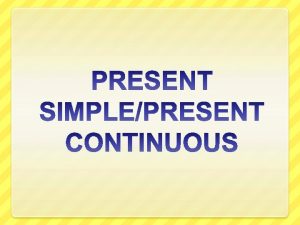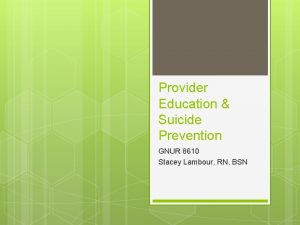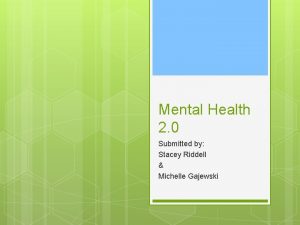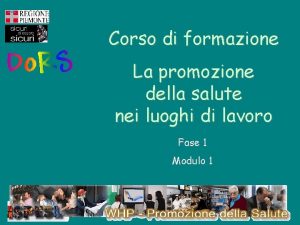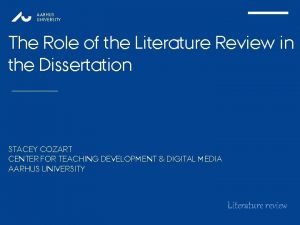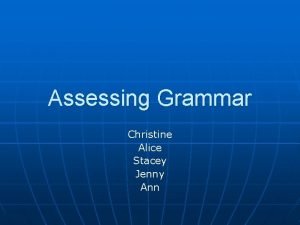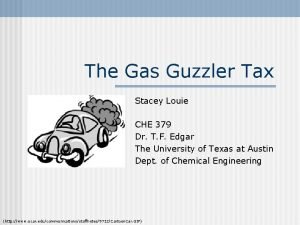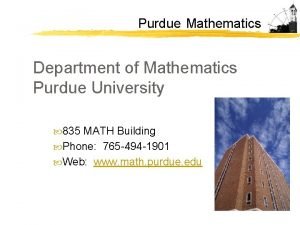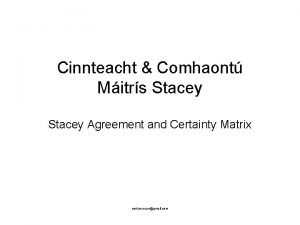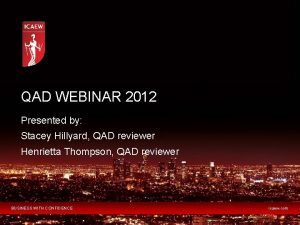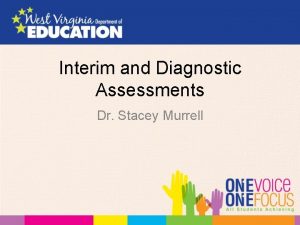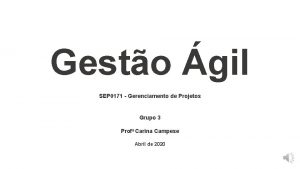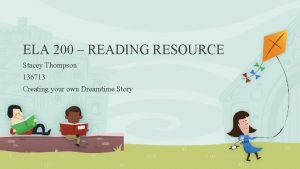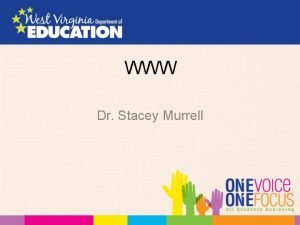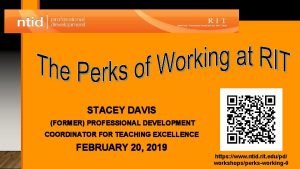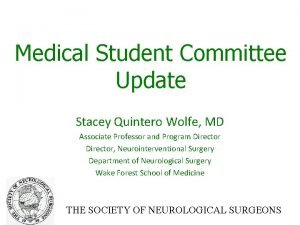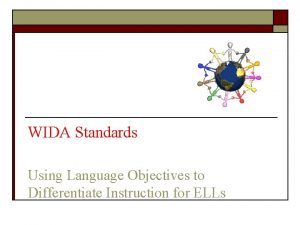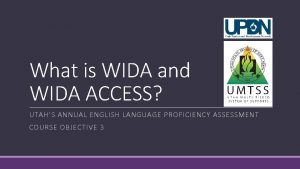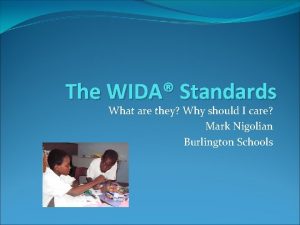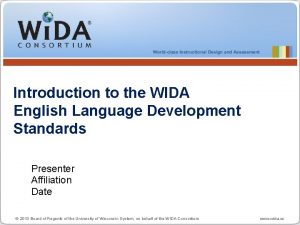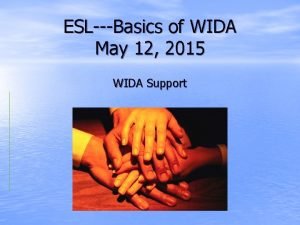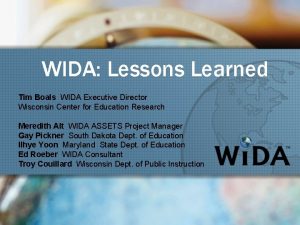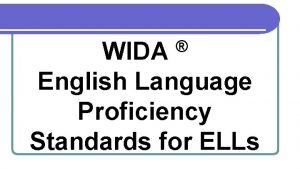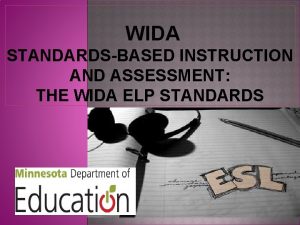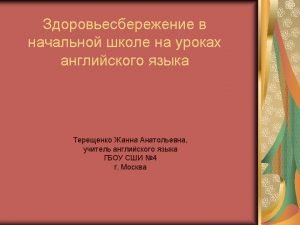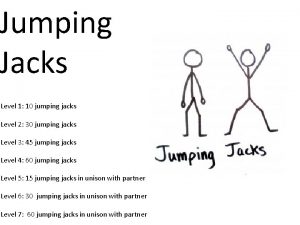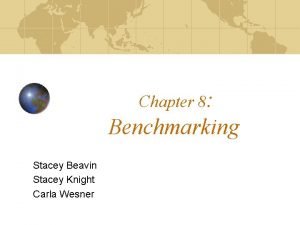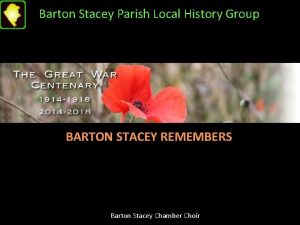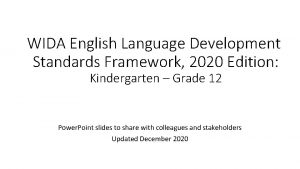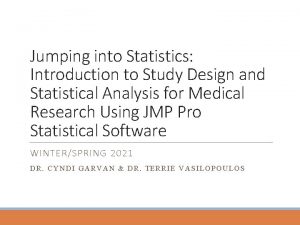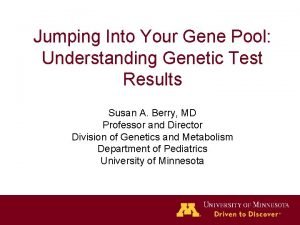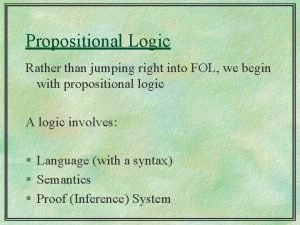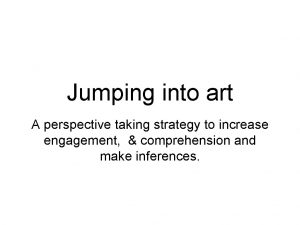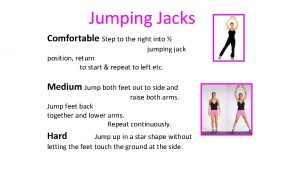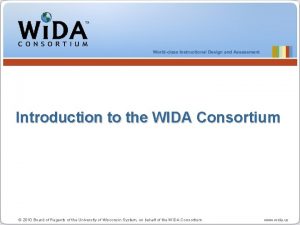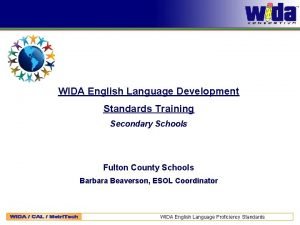INTRODUCTION TO WIDA JUMPING INTO THE FRAMEWORK STACEY

























- Slides: 25

INTRODUCTION TO WIDA – JUMPING INTO THE FRAMEWORK STACEY GILLISH, AMY HAYCOCK, JULIE LUCAS

WELCOME AND INTRODUCTIONS Instructor Intros Sound Off For Grade Levels

WORKING AGREEMENTS Ask Questions and Construct Answers Engage Fully and Embrace Discomfort Integrate and Construct New Information Open Your Mind to Diverse Views and Value Others’ Strengths Utilize What You Learn, Share it, and Feed it Back

CAFÉ CONNECTIONS Use of the WIDA Framework can make text across content areas accessible and comprehensible by building on what students Can Do. Standards Domains Features of Academic Language Performance Definitions Chapter 6 from Best Practices in Literacy Instruction

GOALS AND OBJECTIVES Participants will develop a working understanding of the WIDA framework through analyzing academic language of text and student writing samples. Participants will discuss the ELD Standards, Language Domains, Features of Academic Language, and Performance Definitions from WIDA. Participants will write notes about the different Features of Academic Language while analyzing text. Participants will make posters that evidence an understanding of the WIDA Framework. Participants will sort the Performance Definitions

DID YOU KNOW? WIDA has 10 Guiding Principles of Language Development Each person will read their Guiding Principle Buddy up with someone and ask them your Did You Know Guiding Principle and make a connection Switch Guiding Principles and find a new partner Repeat

HEART AND SOUL “What is it that differentiates students who make it from those who do not? This list is long, but very prominent among the factors is mastery of academic language. ” -Lily Wong Fillmore, Ph. D “Most scholars believe that instruction in academic English ' done early, consistently, and simultaneously across content areas ' can make a difference in English learners' ability to understand the core curriculum. ” – U. S. Department of Education

DESCRIBE THIS PICTURE in about 1 minute… 1. …as if you’re talking to your best friends from school. 2. … with the heart and soul of a historian. 3. … with the heart and soul of a mathematician. 4. … with the heart and soul of a scientist. 5. … with the heart and soul of a poet. 10/18/2016 8

HEART AND SOUL How did language differ from voice to voice? How does this activity apply to the teaching of ELs?

NEVADA ELD STANDARDS How many ELD standards are there? What are they? Discuss at your table: • What do they have in common? • Why only 5 standards? • How do they work? 10

DOMAINS OF LANGUAGE Domain Receptive • How we acquire and process information. • Not “observable” Productive Description process, understand, interpret, and Listening evaluate spoken language in a variety of situations engage in oral communication in a variety Speaking of situations for a variety of purposes and audiences • How we express or communicate information. Reading process, interpret, evaluate written language and symbols, and text with understanding and fluency • Easier to assess. Writing engage in written communication in a variety of forms for a variety of purposes and audiences

DOMAINS OF LANGUAGE – ACCESS SCORES

FEATURES OF ACADEMIC LANGUAGE

FEATURES OF ACADEMIC LANGUAGE Analyzing Academic Text for the Features Linguistic Complexity/Discourse (ideas organized, purpose of text) Language Forms and Conventions/Sentence (verb tenses, simple, complex, pronoun usage) Vocabulary/Word and Phrase (content specific, key words) Anything else you notice about text that might make it difficult for ELs?

FEATURES OF ACADEMIC LANGUAGE Analyzing the Features of Academic Language Through Content Area Text Break into small groups of Primary (K-3), Intermediate (4 -6), or Secondary (7 -12) *6 in a group is ideal Your group will be given a piece of text from one of the content areas Analyze the text for the Feature of Academic Language (Discourse/Linguistic Complexity, Sentence/Forms and Conventions, Word or Phrase/Vocabulary Usage) Break up work in pairs depending on size of group You will come together as a group to record your findings on a group poster

FEATURES OF ACADEMIC LANGUAGE Discourse and Complexity Sentences and Grammatical Structures Words and Phrases

GALLERY WALK Look for samples of: Discourse Sentence Structure Vocabulary Aha’s to share whole group

PERFORMANCE DEFINITIONS (in all content areas) These are the features expanded into proficiency levels.

PERFORMANCE DEFINITIONS Performance Definition Sort Complete sort with a partner Compare with table mates Raise hand to get answers and compare

ANALYZING AND SCORING STUDENT WRITING Student sample of writing Grade Band 1 -2 Score using performance definitions in all three areas Be ready to discuss in 5 minutes

AND 1 -2 – Green Discourse – Red Sentence – Orange Word/Phrase Upper/lower case errors don’t impede Simple andcontent expanded sentences the overall meaning – doesn’t reflect that first Some specific language: show emerging complexity. One language interference. Present simple is Animal names probably from a prompt. compound sentence (but), one typical of scientific descriptive writing. Use of technical language (rings, Coherent cohesive. Veryfragment. patterned. Correct and adj-noun word b. ELy). (3) Parallel construction. order. Pronoun use. (5) (3 -4)

ANALYZING AND SCORING STUDENT WRITING Student sample of writing Grade Band 6 -8 Score using performance definitions in all three areas Be ready to discuss in 5 minutes

GRADE BAND 6 -8 – Green Discourse – Red Sentence – Orange Word/Phrase Compound/complex grammatical Social and instructional & of Idea with related details: words Chunks constructions: Somewhat comprehensible expressions: kasen (= cousin), simple sentences. Phrases and park short, game, often impeded by errors(=inawesome). sp. ELing, syntax play, my, when, osom sentences. Varied amount of text. (first language interference). Understanding of sound-letter. Formulaic Some sense of organization. (2 -3) grammatical structures. (2 -3) correspondence. (1 -2)

GOALS AND OBJECTIVES Participants will develop a working understanding of the WIDA framework through analyzing academic language of text and student writing samples. Participants will discuss the ELD Standards, Language Domains, Features of Academic Language, and Performance Definitions from WIDA. Participants will write notes about the different Features of Academic Language while analyzing text. Participants will make posters that evidence an understanding of the WIDA Framework. Participants will sort the Performance Definitions

CLOSING With the coming week in mind, on a sticky, write: One way that you will be able to apply the WIDA framework in your work with ELs One way you will share this information with your team Be ready to share in 2 minutes. If you have questions you would like answered in Session B, please write them on a sticky and make sure we get them before you leave class today. Please complete the Session Evaluation Thank you!!!
 Repeated action sentences
Repeated action sentences Stacey lambour
Stacey lambour Stacey ridell
Stacey ridell Matrice di stacey
Matrice di stacey Stacey barta
Stacey barta What bridge is the strongest
What bridge is the strongest Stacey cozart
Stacey cozart Alice stacey
Alice stacey Gas guzzler tax
Gas guzzler tax Purdue math building
Purdue math building Agreement certainty matrix
Agreement certainty matrix Stacey hillyard
Stacey hillyard Saint empire romain germanique
Saint empire romain germanique Stacey murrell
Stacey murrell Diagrama de stacey
Diagrama de stacey Ela 200
Ela 200 Stacey murrell
Stacey murrell Rit shear global
Rit shear global Stacey quintero wolfe
Stacey quintero wolfe Stacey johnson nottingham
Stacey johnson nottingham Wida language objectives
Wida language objectives Wida access certification
Wida access certification What is wida
What is wida Symilax
Symilax Model performance indicators wida
Model performance indicators wida Wida taxonomy language acquisition
Wida taxonomy language acquisition
